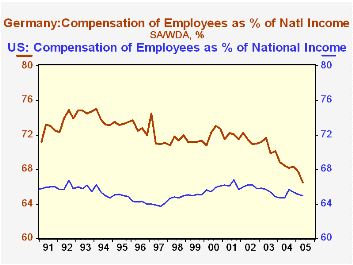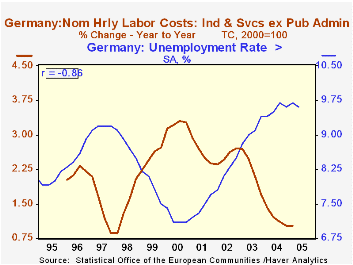 Global| Sep 21 2005
Global| Sep 21 2005Labor Costs Weak in Europe, Following Slow GDP Growth
Summary
It is widely observed that there are major dislocations in European labor markets. Debate over reforms of present labor regulations in Germany, for instance, has basically paralyzed the government as last Sunday's elections gave no [...]

It is widely observed that there are major dislocations in European labor markets. Debate over reforms of present labor regulations in Germany, for instance, has basically paralyzed the government as last Sunday's elections gave no party or policy anything close to a majority vote.
Thus, it is interesting that data reported today by Eurostat show that hourly labor costs in Europe have been rising rather modestly, and they compare favorably with similar information for the US. In the overall Euro-Zone, this gauge rose a mere 0.5% in Q2 (2.1% annualized) and was just 2.3% above a year ago. In Germany, where there is much distress in the labor market, the hourly labor cost index edged up just 0.1% in the quarter, and as seen in the table below, just 0.8% from a year ago. Somehow, public discussion of these labor developments gives the impression that the associated costs are quite high. But these costs increasing very slowly, and in the second graph, it is seen that they are retreating rapidly as a share of national income.
In the face of high unemployment in Germany, what we seem to have is an excellent example of a Phillips Curve phenomenon: high unemployment combined with low inflation of labor costs. Generally this is seen as a demand-driven condition, but here it is likely exacerbated by the rigidities in the applicable regulations.
In Europe as a whole, demand appears to be a leading force on labor costs. The correlation of GDP growth (in nominal terms) with labor cost increases is 48% in the same quarter, but with a two-quarter lead for GDP, the correlation jumps to 76%. In the last two quarters the pace of GDP has slowed further, suggesting that it is difficult to look for much improvement in labor compensation over the remainder of this year.
| Hourly Labor Cost Index | Q2 2005 | Q1 2005 | Q4 2004 | Q4/Q4|||
|---|---|---|---|---|---|---|
| 2003 | 2002 | 2001 | ||||
| Euro-Zone (SA, 2000=100) | 116.0 | 115.4 | 114.6 | 111.8 | 108.8 | 105.1 |
| Year/Year % Change* | 2.3 | 3.0 | 2.2 | 2.6 | 3.5 | 3.6 |
| Germany | 0.8 | 1.2 | 0.5 | 1.5 | 2.2 | 2.2 |
| France | 2.7 | 3.3 | 2.9 | 2.3 | 3.8 | 4.1 |
| Spain | 4.4 | 4.4 | 4.4 | 4.0 | 5.3 | 7.0 |
| US | -- | 3.4 | 3.8 | 4.0 | 3.2 | 4.2 |
Carol Stone, CBE
AuthorMore in Author Profile »Carol Stone, CBE came to Haver Analytics in 2003 following more than 35 years as a financial market economist at major Wall Street financial institutions, most especially Merrill Lynch and Nomura Securities. She had broad experience in analysis and forecasting of flow-of-funds accounts, the federal budget and Federal Reserve operations. At Nomura Securities, among other duties, she developed various indicator forecasting tools and edited a daily global publication produced in London and New York for readers in Tokyo. At Haver Analytics, Carol was a member of the Research Department, aiding database managers with research and documentation efforts, as well as posting commentary on select economic reports. In addition, she conducted Ways-of-the-World, a blog on economic issues for an Episcopal-Church-affiliated website, The Geranium Farm. During her career, Carol served as an officer of the Money Marketeers and the Downtown Economists Club. She had a PhD from NYU's Stern School of Business. She lived in Brooklyn, New York, and had a weekend home on Long Island.





